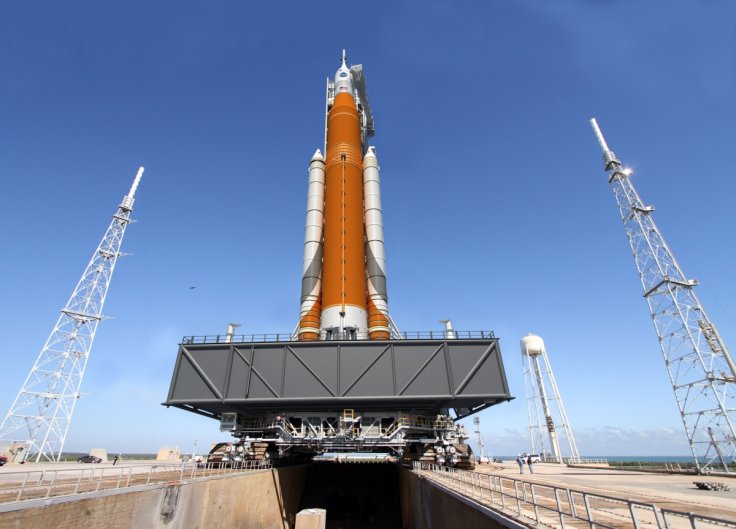For a decade now, the US National Aeronautics and Space Administration (NASA) has been developing a heavy-lifting launch vehicle that could be used to send humans back to the moon. Dubbed as Space Launch System (SLS), it is supposed to be the most powerful rocket ever built. However, since 2011, SLS has been plagued with problems. The latest setback came on Saturday (January 16) when the test had to be aborted following a premature engine shutdown.
The SLS is NASA's one of the most expensive and ambitious projects that will replace the Space Shuttle. With delays and mounting costs, NASA's SLS project has been criticized numerous times. But on Saturday, it all seemed to pay off when the SLS blasted four engines. The test was to simulate the thrust that would lift off the rocket with a payload. The engines were supposed to fire for eight minutes. Instead, one of the engines suffered a "major component failure" and shut down just 67 seconds into the test at Stennis Space Center in Mississippi.

NASA Administrator Jim Bridenstine said that the team gained valuable data even though the engines did not fire for the full duration. "Saturday's test was an important step forward to ensure that the core stage of the SLS rocket is ready for the Artemis I mission, and to carry crew on future missions. Although the engines did not fire for the full duration, the team successfully worked through the countdown, ignited the engines, and gained valuable data to inform our path forward," he said.
What Went Wrong?
As the SLS' four Aerojet Rocketdyne RS-25 engines fired with a total thrust capacity of 1.6 million pounds, burning 700,000 gallons of propellants, it all seemed great for few moments. But 60 seconds into the test, the flight controller announced, "We did get an MCF on Engine 4."
While it is not known what caused the MCF or major component failure, the test ended in 67 seconds, enough to cause concern. "We don't know what we don't know. It's not everything we hoped it would be," said Bridenstine, who will step down once President-elect Joe Biden takes office.
John Honeycutt, SLS' program manager, said the problem appeared about 60 seconds into the test as engines began throttling down from 109 percent to 95 percent and moved their axis of thrust. While more investigation will be required to understand the underlying cause, Honeycutt said that a "flash" in the thermal protection blanket on Engine 4 was noted. The blankets protect engines from overheating due to the burn of other engines.
What Happens to Artemis I Now?
While Bridenstine said that NASA was able to get important data, it is unlikely that it is enough. NASA will have to conduct the hot fire test again before any planned launch. But for now, NASA will need to study the data and understand the cause of the flash. That will take time as NASA will have to coordinate with Boeing, who is building the rocket and Rocketdyne, who is developing the engine.
If the problem was with just Engine 4, it could be swapped out for another one. It will take about a week or 10 days. But for another hot fire test to occur, it will take months. Hence, NASA's plan to launch an unmanned mission to the moon in 2021 will likely be pushed to 2022.
However, the other problem is the Biden Administration. Unlike Donald Trump, who emphasized sending Americans back to the moon by 2024, Biden hasn't announced his plans for space exploration. According to Reuters, the Biden Administration is likely to delay the project further and 2024's manned Artemis mission is unlikely.
Furthermore, the funding for NASA has always come from Congress, mainly Republican lawmakers. Democrats have favored private companies to provide NASA with launch vehicles. Now that Republicans have lost the majority in both Senate and House, SLS' future remains unclear.
SLS' major backer has been from Alabama as the rocket has been designed and managed in Marshall Space Flight Center in the state, creating thousands of jobs as per an Ars Technica report. Alabama senator Richard Shelby, the chairman of the Senate Appropriation Committee, had the power to dictate NASA's budget. But with Democrats taking the Senate, it could become a major problem for NASA. With SpaceX is also testing its heavy-lifting rocket Starship, it remains to be seen what Congress does in the upcoming days.
The other backer was Republican Congressman Mo Brooks, also from Alabama. But his clout has dwindled in recent weeks and has been immensely criticized for his role in the January 6 Capitol riots that resulted in five deaths. With Alabama delegation losing its political clout in Congress, SLS' future will remain unclear as the Democrats are likely to favor an economic overhaul due to the COVID-19 pandemic.








